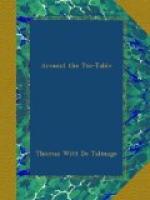The whole scene is unique and incomparable. The Yosemite makes us think of the Alps; San Francisco reminds us of Chicago; Foss, the stage driver, hurling his passengers down the mountain at break-neck speed, suggests the driver of an Alpine diligence; Hutchings’ mountain horse, that stumbled and fell flat upon us, suggested our mule-back experiences in Tete Noir Pass of Switzerland; but the geysers remind us of nothing that we ever saw, or ever expect to see. They have a voice, a bubble, a smoke, a death-rattle, peculiar to themselves. No photographist can picture them, no words describe them, no fancy sketch them.
You may visit them by either of two routes; but do not take the advice of Foss, the celebrated stage driver. You ought to go by one route, and return the other; yet Foss has made thousands of travelers believe that the only safe and interesting way to return is the way they go—namely, by his route. They who take his counsel miss some of the grandest scenery on the continent. Any stage driver who by his misrepresentations would shut a tourist out of the entrancing beauties of the “Russian Valley” ought to be thrashed with his own raw-hide. We heard Foss bamboozling a group of travelers with the idea that on the other route the roads were dangerous, the horses poor, the accommodations wretched and the scenery worthless. We came up in time to combat the statement with our own happy experiences of the Russian Valley, and to save his passengers from the oft-repeated imposition.
And thus I have suggested the chief annoyance of California travel. The rivalries of travel are so great that it is almost impossible to get accurate information. The stage drivers, guides and hotel proprietors, for the most part, are financially interested in different routes. Going to Yosemite Valley by the “Calaveras route,” from the office in San Francisco where you buy your ticket to the end of your journey, everybody assures you that J.M. Hutchings, one of the hotel




